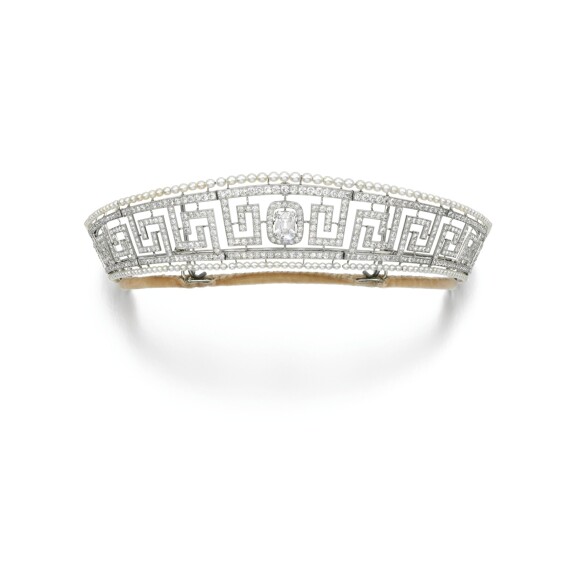- 498
珍珠配鑽石皇冠, 卡地亞(Cartier)
描述
- seed pearl, diamond, metal
• 希臘式回紋造型
• 圓形鑽石及小顆珍珠
• 皇冠前方中央鑲一顆圓形鑽石,可拆除
• 內圓周305毫米
• 無款識
• 後配備皇冠框
• 盒子印有卡地亞品牌標誌
*拍品資料以英文為主,中文翻譯僅供參考
來源
出版
Cf.: For additional information about the sinking of the RMS Lusitania please refer to "Robert Paterson Lusitania" a web blog account of the final voyage written by a relative of Lady Allan.
Cf.: www.rmslusitania.info
Condition
"In response to your inquiry, we are pleased to provide you with a general report of the condition of the property described above. Please note that colour, clarity and weight of gemstones are statements of opinion only and not statements of fact by Sotheby's. We do not guarantee, and are not responsible for any certificate from a gemological laboratory that may accompany the property. We do not guarantee that watches are in working order. Prospective buyers should inspect each lot to satisfy themselves as to condition and must understand that any statement made by Sotheby's is merely a subjective, qualified opinion. Prospective buyers should also refer to refer to any Important Notices regarding this sale, which are printed in the Sale Catalogue, in particular to the Notice regarding the treatment and condition of gemstones and to the Notice regarding import of Burmese jadeite and rubies into the US.
NOTWITHSTANDING THIS REPORT OR ANY DISCUSSIONS CONCERNING A LOT, ALL LOTS ARE OFFERED AND SOLD "AS IS" IN ACCORDANCE WITH THE CONDITIONS OF BUSINESS PRINTED IN THE SALE CATALOGUE."
拍品資料及來源
In October 1893 he married Marguerite Ethel Mackenzie. They had three daughters and one son, and lived in an imposing 72 room mansion, Ravenscrag, in Montreal, Quebec. Tragically Lady Allan lost both of her daughters, Anna and Gwendolyn in the sinking of the RMS Lusitania and their only son Hugh Allan in the Great War on his first patrol with the Royal Navy Air Service in Belgium in 1917. Their surviving daughter Marguerite Martha, went on to found the “Montreal Repertory Theatre”, although her mother went on to outlive her by 15 years.
In 1915 Lady Allan booked passage on the RMS Lusitania travelling from New York to Liverpool, accompanied by two of her three daughters, Anna Marjory and Gwendolyn Evelyn, two maids: Emily Davis and Annie Walker, and a suite of luggage that included amongst her jewels, the Cartier diamond tiara. She was travelling to Great Britain to organise and open a hospital for Canadian servicemen. The Lusitania began service in 1907, and at the time was the largest and one of the fastest ocean liners in service on the North Atlantic run, frequently taking the Blue Riband from her rivals. At the outbreak of the Great War, although the Lusitania was considered for requisition, it was ruled out due to her size and the risk of U boats that such a large ship would present, as such she was to continue her transatlantic crossings reduced to one a month due to war time economies.
On 4 February 1915, Germany declared the seas around the British Isles a war zone, and that allied ships entering British waters risked attack from German U boats without prior warning. In spite of the risks involved and the Imperial German Embassy of Washington placing a warning below an advertisement for the Lusitania's return voyage on the day of her departure, on 1 May 1915, many felt that the ships speed made her safe. Even without her full capacity the Lusitania could still achieve a speed of 21 knots, 10 knots faster that the German U boats.
By sheer misfortune at 2.10pm, within sight of the coast of Ireland, the Lusitania crossed in front of the German U-boat U-20, low on fuel and with only three torpedoes left she was ironically preparing to return home. Captain Schwieger gave the order to fire and in spite of his quartermaster’s refusal to attack women and children, action which was later to result in his court-martial and imprisonment, another crewman took over and a single torpedo was launched.
The torpedo struck just aft the bridge, causing the liner to list as water flooded into the starboard compartments, as the Lusitania sped on at 18 knots, forcing water into her hull and plowing the ship into the sea. The liners precarious list to starboard prevented the passengers safely boarding the starboard boats while the port boats risked being smashed as they dragged on the ships rivets or crashed in on the deck. The chaos was compounded as none of the lifeboats could be safely lowered until the ship slowed which was impossible to achieve as she was no longer responding, the torpedo having knocked out the controls to slow her. Many lifeboats overturned while being loaded and lowered, while others were overturned by the ships motion, of the 48 lifeboats on board only 6 where successfully lowered. Within 6 minutes the Lusitania’s forecastle began to go underwater, and it was a full 10 minutes until the liner had slowed enough to safely start putting the boats in the water. The Lusitania sank in 18 minutes with the loss of 1,198, of the 1,989 passengers on board, including almost 100 children, amongst those the two daughters of Lady Allan. Lady Allan survived the disaster although severely injured with a broken collarbone along with her two maids.
Although their was international condemnation of the attack in which 128 American citizens lost their lives, America did not declare war on Germany, and in September of 1915 the Kaiser called off unrestricted submarine warfare completely.

